The Peranakan Museum in Singapore is the world’s largest museum dedicated to the colourful and distinctive culture of the Peranakans. Through ten themed galleries, visitors can explore various aspects of the Peranakan culture, such as wedding and religion.
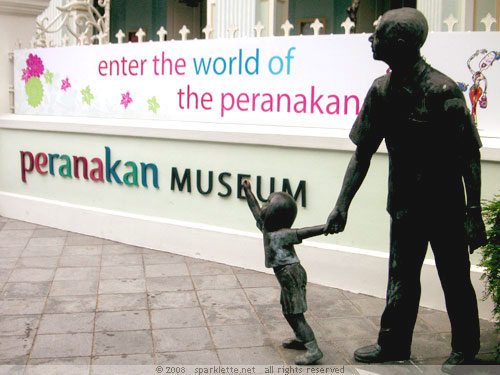
(I really like this sculpture of a little girl pulling her Daddy towards the main entrance of the museum. Yes, this is also the place where I found the cute cat sculpture!)
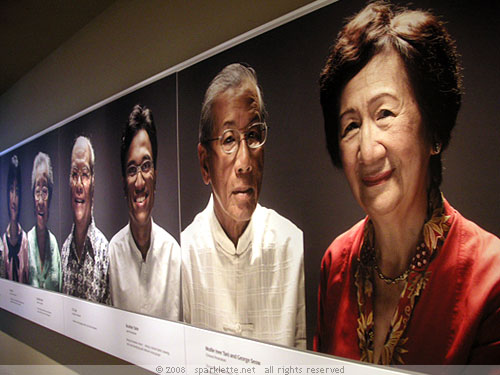
It is a good idea to start touring the museum from the ground floor gallery. Here, you would learn about the origins of the Peranakans as larger-than-life-sized portraits of Peranakans surround you.
So who are the Peranakans? When merchants and travellers came to Southeast Asia centuries ago, many settled down here and started families with the locals. Their descendants are the Peranakans, who developed a new hybrid culture with Chinese, Malay, Indian and European influences.
Once you are better acquainted with the origins of the Peranakans, advance to the second floor. Four galleries occupy this entire level, with a focus on the 12-day traditional Peranakan wedding. This was an elaborate affair that started from the time the bride left her parents’ home to when she moved in with her new in-laws.
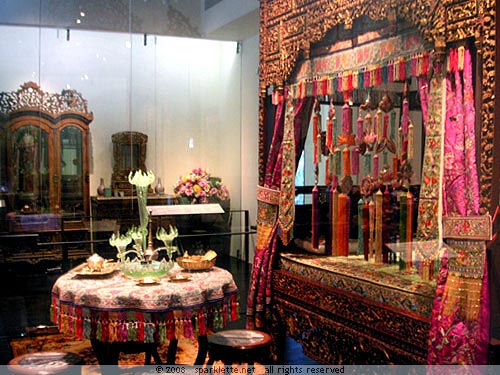
In this display of a wedding chamber, the antique ranjan kahwain (wedding bed) is decorated with ornate carvings of fertility symbols, intricate embroidery and colourful tassels.
Here’s one customary tradition that I find particularly interesting. Before the wedding, a young boy from a family with many sons would be asked to roll across the bed three or four times. It was believed that this way, his “male energy” would increase the new bride’s chances of having baby boys.
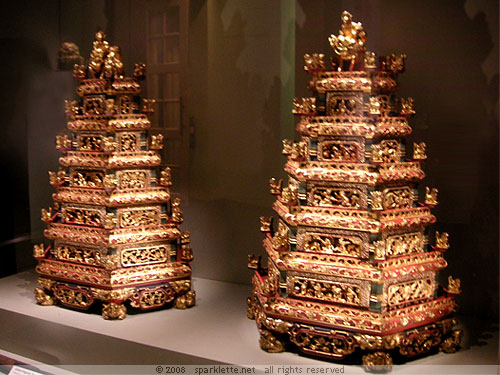
Such multi-tiered gold pagoda trays are unique pieces used in the gift-exchanging practice between families of the bride and groom, a significant ritual during the wedding.
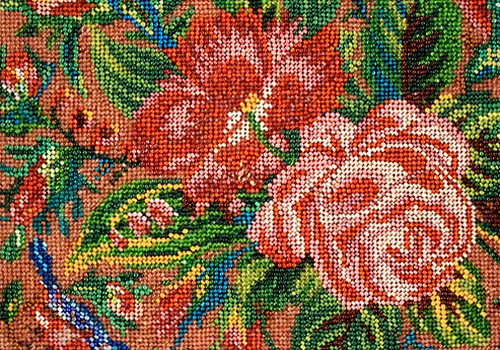
Photo by Soo Ching
Nonyas (Chinese Peranakan women) are well-known for their skillfulness in embroidery and beadwork. A Nonya bride was often judged on her needlework before she was fully accepted by her new family. This is why from a young age, Nonyas had to devote long hours to perfecting their techniques.
At the museum, a whole section has been dedicated to these intricate crafts. On display are beadwork slippers, beadwork slipcases, beadwork tablecloths, beadwork vases and more!
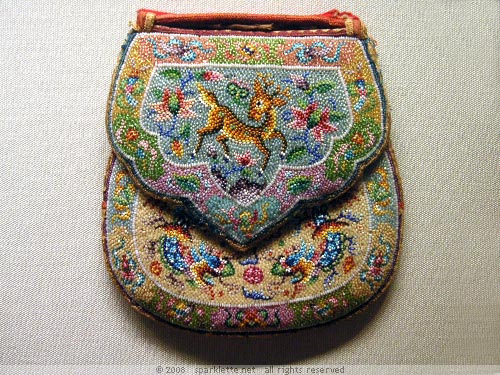
This colourful beadwork wedding purse features deer and dragon motifs. Not only are the glass beads minuscule (typically imported from Europe), thousands of them have been painstakingly threaded together to create the densely beaded design. It would have taken a Peranakan woman of exceptional skill, not to mention time and effort, to make this purse!
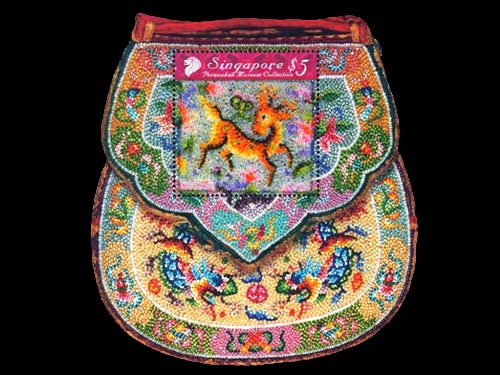
To celebrate the opening of the Peranakan Museum, SingPost (Singapore’s designated provider of domestic and international postal services) has issued the world’s first beaded stamp based on this very purse, featuring caviar beads that are hand-pasted. How exquisite! It makes a really pretty souvenir, don’t you think?
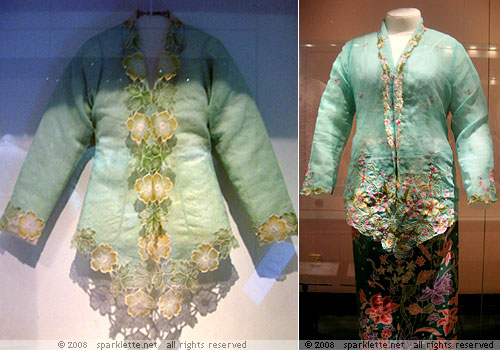
And here’s the famous sarong kebaya! This still remains the attire of choice for Nonyas today. Made from an assortment of batik, embroidery, beadwork, silk, satin and organdy, these long-sleeved blouses are the result of a blend of various cultural influences.
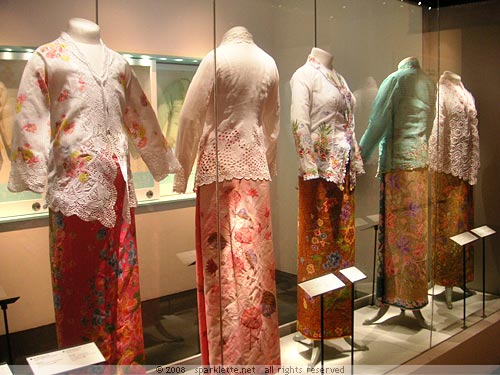
Over the years, the silhouette of the sarong kebaya has changed from being loose-fitting to one that better accentuates the womanly figure. The most famous kebaya is probably the one worn by the SIA flight stewardesses!

As an affluent community, the Peranakans certainly spared no expense in acquiring such ornate gold jewellery! These gold tangkal (amulets) were more than just ornamental; they also served to protect the wearer from evil forces and malicious spirits.
Look closely and you would notice that a few of these are in the shape of the bagua (octagon). The bagua is a significant daoist symbol that represents balance between positive and negative cosmic forces. Word has it that this is also why the Singapore $1 coins bear the same shape. But let’s leave that story for another day, shall we?
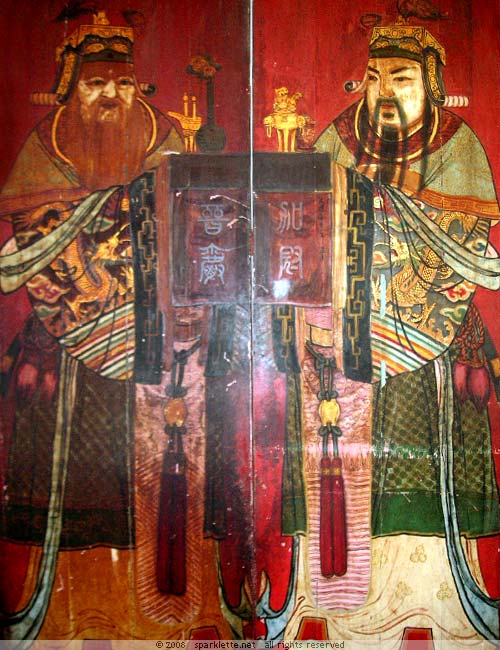
Moving on to my most favourite part of the museum – the Religious Gallery. Traditionally Peranakans embraced a mixture of religious beliefs from China, such as Daoism, Buddhism, ancestral and spiritual worship. As they interacted with the British colonial rulers, many converted to Catholicism.
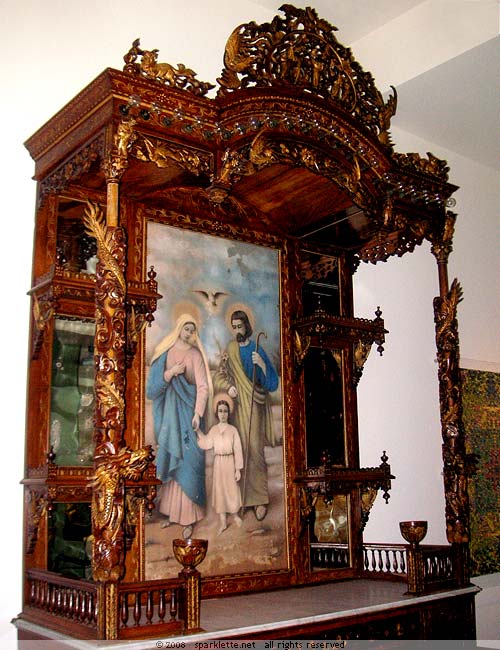
Judging from the carvings on the frame, this large piece of ornate furniture was originally a Daoist altar. When the owners converted to Catholicism, it was reused as a catholic altar with the addition of a central catholic devotional image of the Holy Family.
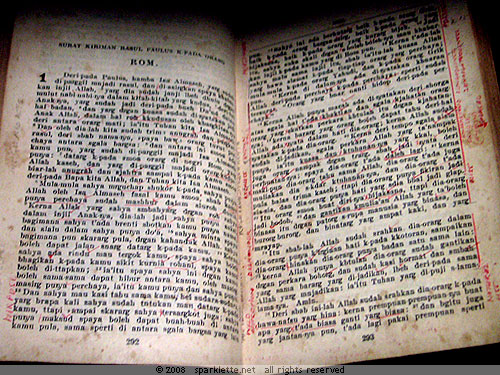
What you see here is the new testament in the Peranakan language of Baba Malay. Despite its long history – it was published in Singapore in 1913 – what really intrigues me is the next exhibit.

This ornamented mid-size crucifix is undoubtedly one of the museum’s rarest artifacts, if not the rarest. Crafted out of rosewood with mother-of-pearl inlays, it holds a sacred relic of the true cross. Yes, that’s the cross on which Jesus Christ was crucified. Fragments of the cross were distributed after it was found in the early 4th century, one of which is now contained in this crucifix.
Within this same gallery at the end of a dark corridor, you should notice a mirror on which a rather unsettling large red X is taped. You may wish to turn away, for this leads to a gloomy room decked out like a Peranakan funeral wake. There’s even a real coffin decorated with a colourful embroidered cover, complete with background sounds of mourners.
“The coffin is actually not empty, we’ve put some wood inside, because our belief is that a coffin cannot be left empty or it calls for someone,” says Randall Ee, a curator at the museum.
Ahem, that’s a little too creepy for me! Now, how about something a little less gloomy?
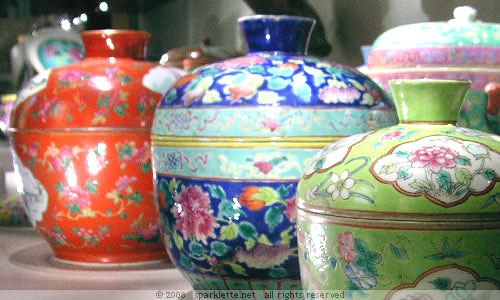
These colourful containers are kamchengs (covered containers used for storing food, drinking water and desserts), the most recognised form of Nonyaware. While Chinese utensils tend to be plainly decorated with pale colours, Nonyaware is distinguished by their vivid enameled tints on a brilliantly-coloured background, with auspicious phoenix and peony motifs.
“The Chinese wanted to appreciate the whiteness on their porcelains because it tells you of the quality of the firing, but the Peranakans appreciated the colour and the form – not so much the porcelain – so their porcelain is completely covered with colour,” Ee explained.
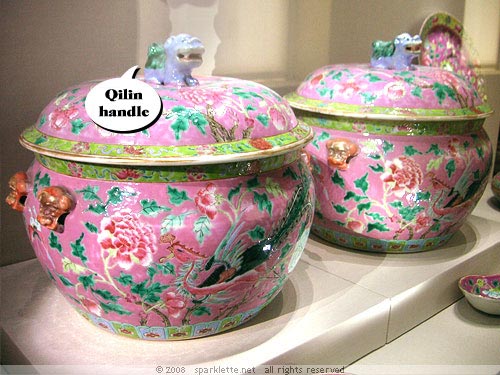
Kamchengs of this size were very rare and could only be afforded by the wealthiest Peranakan families. Notice how the lid is topped with a finial in the shape of a qilin (a Chinese mythical animal)? I find this detail very cute!
So far we have seen many treasured antiques of the Peranakans. But there are also modern exhibits such as contemporary paintings. Kenson Kwok, the museum director says, “We don’t want the museum to be seen just as a celebration of the past. It is also a record of the present, and we have tried to look at the taste of the Peranakan and re-interpret it in a contemporary way.”

Adoring the Phoenix is a pair of acrylic paintings done by local artist Desmond Sim in 2007. Set on oval-shaped canvases, the artist has chosen to paint this in the rich, vivid colours favoured by the Peranakans. Once again, there’s the peony and the phoenix, two recurring elements in Peranakan arts.

A temporary exhibition titled “Junk to Jewels” showcases personal items on loan from several Peranakan families. Exhibits include toys, kueh ku (a type of Peranakan cake) moulds, recipe books, beadwork items, wedding shoes from the 1900s and jewellery.
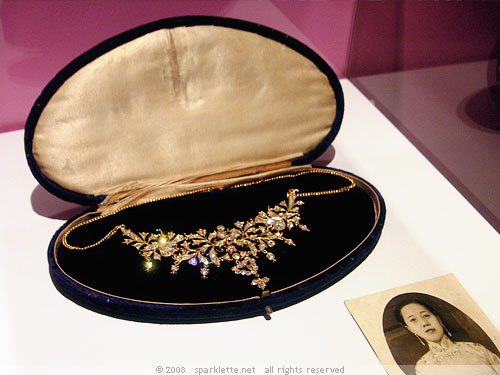
Each exhibit comes complete with its own personal story, allowing us to better relate to the objects and understand the lives of the Peranakans.
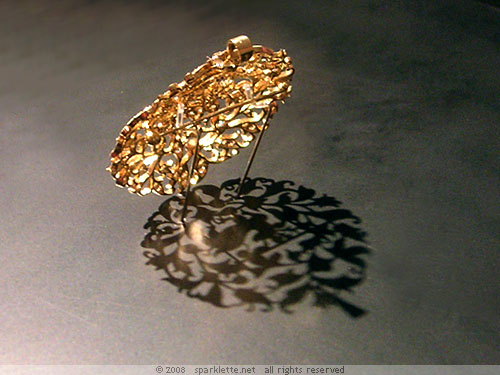
The gold jewellery are characterised by their finely-detailed patterns, as seen in this gold brooch.
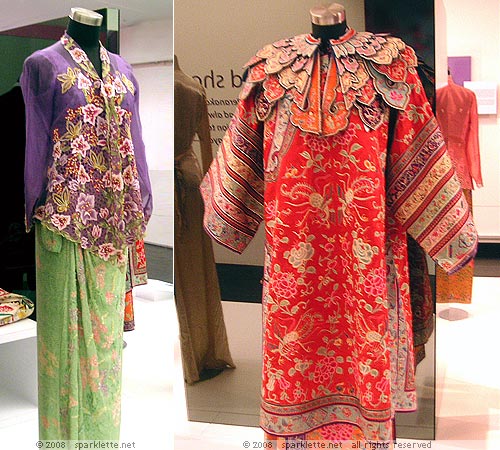
The beautiful sarong kebaya in a combination of purple and green. On the right is the traditional wedding garment made of heavily embroidered silk worn by the Nonya brides. It is adorned with pairs of phoenixes and peonies.

As a fan of jigsaw puzzles, I find the unusual Zag-Zaw picture puzzle particularly intriguing. The pieces are hand-cut into irregular shapes, much unlike modern puzzles. To top it all, the puzzle do not come with any guide or illustration, making it extremely difficult to assemble. From the little story, it seems that no one in the family has managed to put the pieces together. I wonder if we can still find this anywhere today? I would love to give it a go!
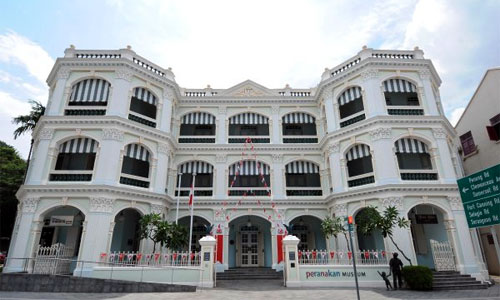
So, are you ready to immerse yourself in the colourful world of the Peranakans? Take a trip to this vibrant museum. There are simply so many beautiful aspects of this vibrant ethnic culture, so many discoveries to make, you will be enchanted in no time.
39 Armenian Street
Singapore 179941
Tel: +65 6332 7591 | Website
Opening hours:
Mon: 1-7pm
Tue to Sun: 9am – 7pm (to 9 pm on Fridays)
Admission: $6 per adult, $3 per full-time student and National Serviceman
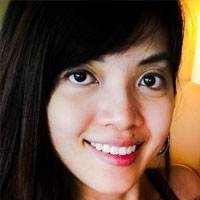
May 12, 2008
182
A great write-up on your visit to the Peranakan Museum, and very well-taken photos too. :)
May 12, 2008
3472
Thanks! Despite being newly opened, this is already easily one of my most favourite museums in Singapore. The things exhibited are oh-so-pretty!
May 13, 2008
14
wow. the peranakan handicrafts are so fine n pretty. =)
May 15, 2008
72
Thank you for this beautiful and brilliantly done post on our newest baby on the block. Like you, I am also a great fan of the new museum, and it has proven to be an endless source of fascination when I first visited it. You have certainly given it your usual extraordinary Sparklette touch here! ;)
May 15, 2008
3472
My Sparklette touch? Whoa, I like the sound of that! Never knew there was anything special :)
May 15, 2008
182
By the way, I am not sure if you are aware that some of the photos here don’t seem to load well today? The photos had loaded alright a couple of days ago.
May 15, 2008
3472
You are right. I only noticed it when I got home from work today. My host has looked into this for me and tweaked a few things. The site should load better now. Thanks!
May 29, 2008
24
Thanks so much for sharing, the wedding rituals are so interesting and different in each culture…
Aug 15, 2008
1
i love this site as it explains deeply yet easily understood! beautiful pictures!!
May 4, 2009
2
Very interesting indeed, haven’t noticed it despite my frequent route to Mount Sophia. The exterior gave an impression of “yet-another-lousy-government-building” but I’ll pay a visit soon. Thanks for the write-up and truly wonderful.
May 5, 2009
3472
I’m glad you are giving this place a chance! Personally I am a big fan of the museums under the National Heritage Board. Each one is meticulously designed and holds many intriguing never-seen-before treasures. I learn so much from each visit!
It’s a pity that many people do not find our museums interesting. That’s why I try to blog about them, hoping to cast a colourful light on them and spread awareness :)
May 6, 2009
2
I am a history buff and I travel around visiting local war sites, in particular. Heritage wise, I do wonder around old buildings as old as dated back in colonial days to revisit our cultures and whencesoever how things today had derived. I would love to, if permitted, take some photos of the museum and antiques to add into my history blog. Once again, thanks!
Jan 31, 2011
1
Great pictures, and a nice writeup on a pictorial tour of the museum.
Perankan culture, its rich distinct artifacts, food, and distinct lifestyle, makes its a very easy to identify cultural trait.
What is seldom mentioned, is the fact that the willingness of the Straits Chinese to assimilate and their great ability to adopt and evolve into such a distinct culture. It can be a model of social integration.
Well done for sharring your insights into the facinating facets of the Straits Chinese.
Mar 29, 2011
1
Nice photos. Yes, it’s very detailed about ‘traditional’ Peranakan culture. From a visitor’s point of view, however, they see the ‘Peranakan’ on display, but none of it on the streets of Singapore. It may seem that either Peranakan culture has disappeared, or they are all in hiding. Therefore, the museum could have dedicated more space to what have become of the Peranakan today (i.e. they have largely assimilated into a Singaporean way of wife, but with vestiges of Peranakan-ness still being practiced now and then).
Sep 5, 2012
1
Hi,
For any of those who are eager to have a visit at Peranakan Museum Singapore,
I can give away complimentary pass which grant access to the rest of the museum.
ASIAN geographic, Peranakan Museum Singapore and True Blue Cuisine are organizing a Photo-Story Contest called ‘All Mixed up!’ that runs until 29 September 2012. You just have to post our poster on your FB page, like us – FB/AsianGeo and FB Peranakan Museum Singapore. Now, if you have a unique Peranakan mixture, you can join our game and PLAY. Your portrait will be published in our Magazine, reaching over 428,000 readers across Asia with a subscription base in 54 countries. So stand your chance to have your beautiful Peranakan features on the spotlight. For more information, visit our FB AsianGeo/events